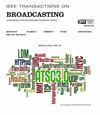亚太赫兹超大规模天线阵列通信系统中基于角域划分波束模式的波束训练
IF 4.8
1区 计算机科学
Q2 ENGINEERING, ELECTRICAL & ELECTRONIC
引用次数: 0
摘要
亚太赫兹(sub-THz)通信被认为是6G网络中的关键技术之一。在亚太赫兹通信中,为了扩大天线的有效孔径和保证接收功率,必须采用超大规模的天线阵列来产生高增益波束。无论在单播还是组播场景下,获取准确的用户信道路径方向都是实现高增益波束形成和高效用户调度的必要条件。然而,现有的波束训练方法在时域和频域都存在较大的波束训练开销。为了解决这一问题,我们提出了一种考虑延迟相位预编码结构的基于角域分割波束图(APBP)的波束训练方案。具体来说,定义了一种称为APBP的宽带波束图,它覆盖了整个角域,并通过不同的射频链产生覆盖不同角域分区的波束来实现。然后,揭示了APBP的性质,利用满足两个不同的APBP的目标方向差可以唯一地确定信道路径方向。基于这一特性,我们提出了一种分两阶段的快速波束训练方案。在粗估计阶段,利用满足两种不同apbp的具有素数分割数的波束对信道路径方向进行粗估计。在此之后,一个微调阶段进行操作,以准确地确定通道路径方向。该方案利用仅占用3个时隙的导频和一小部分子载波实现精确的波束训练。理论分析和大量的仿真结果表明,该方案能以接近最优的和速率实现75%的波束训练开销减少。本文章由计算机程序翻译,如有差异,请以英文原文为准。
Angle-Domain Partition Beam Pattern-Based Beam Training in Sub-THz Extremely Large-Scale Antenna Array Communication Systems
Sub-terahertz (sub-THz) communications is considered one of the critical techniques in 6G network. To enlarge the antenna effective aperture and guarantee the received power, the employment of an extremely large-scale antenna array to generate high-gain beams is essential in sub-THz communications. Obtaining accurate channel path directions of users is necessary for achieving high-gain beamforming and efficient user scheduling in both unicast and multicast scenarios. However, the existing beam training schemes for acquiring channel path directions suffer from a large beam training overhead in either time-domain or frequency-domain. To solve this problem, we propose an angle-domain partition beam pattern (APBP) based beam training scheme by considering the delay-phase precoding architecture. Specifically, a wideband beam pattern called APBP is defined which covers the entire angle-domain and is realized by generating beams that cover different angle-domain partitions through different radio-frequency chains. Then, the property of the APBP is revealed that the channel path direction can be uniquely determined by using the targeted direction difference of beams satisfying two different APBPs with coprime partition numbers. Based on this property, we propose a fast beam training scheme with two stages. In the coarse estimation stage, the channel path directions are coarsely estimated by utilizing beams satisfying two different APBPs with coprime partition numbers. After that, a fine-tuning stage is operated to accurately decide the channel path directions. The proposed scheme is able to achieve accurate beam training by utilizing pilots occupying only three time slots and a small part of subcarriers. Theoretical analyses and extensive simulations have shown that the proposed scheme can realize a 75% reduction in beam training overhead with the near-optimal achievable sum-rate.
求助全文
通过发布文献求助,成功后即可免费获取论文全文。
去求助
来源期刊

IEEE Transactions on Broadcasting
工程技术-电信学
CiteScore
9.40
自引率
31.10%
发文量
79
审稿时长
6-12 weeks
期刊介绍:
The Society’s Field of Interest is “Devices, equipment, techniques and systems related to broadcast technology, including the production, distribution, transmission, and propagation aspects.” In addition to this formal FOI statement, which is used to provide guidance to the Publications Committee in the selection of content, the AdCom has further resolved that “broadcast systems includes all aspects of transmission, propagation, and reception.”
 求助内容:
求助内容: 应助结果提醒方式:
应助结果提醒方式:


